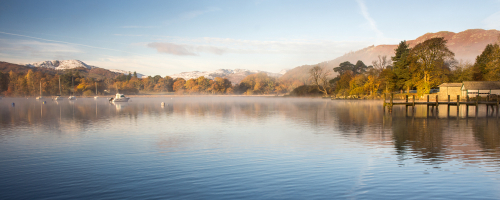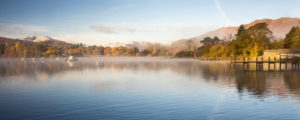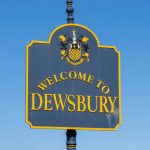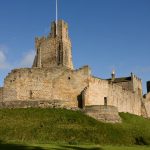
Ambleside is a small market town in Cumbria, in North West England. Historically in Westmorland, it is situated on the northern shore of Lake Windermere, the largest natural lake in England. The town lies within the Lake District National Park, about 4 miles north of the town of Winderemere and is administered by South Lakeland District Council. In the UK census of 2011, the population was recorded as 2,529. Anyway now you know where it is how about a little history?
Ambleside – One of the lake district’s lesser-known gems

Image/ Joe Dunckley/Shutterstock.com
Go to the Cumbria Business Directory
A Brief History Of Ambleside
There is archaeological evidence that suggests the earliest inhabitants of the area in and around Ambleside dates back to Neolithic times. However, it was the Romans who were the first known settlers, when they arrived in the area in the 1st century. They established the fort of Galava at Waterhead on the south edge of the town, which is thought to have housed up to 500 soldiers. The main purpose of the fort was to protect the vital road links to the port at Ravenglass, via Hardknott Pass, and northwards towards Carlisle, one of the main encampments on Hadrian’s Wall.
After the Roman withdrawal from Britain in the late 4th/early 5th centuries, Galava like other forts were abandoned. The precious stone from the fort was soon raided by locals and utilised in the building of their own structures. A new settlement soon began to spring up in the area, firstly on the hill slopes, which later expanded towards the edge of the lake.
During the 8th century, the invading Vikings arrived in Ambleside from Scandinavia. However, the newcomers were not just warriors but also traders and farmers, introducing these new notions to the local population. They were also thought to have been responsible for introducing the hardy Herdwick sheep to the Lake District. The town’s name is thought to have been derived from the Old Norse “Á-mel-sǽtr” which literally translates as ‘river’, ‘sandbank’ and ‘summer pasture’. An alternative theory suggests that it could have been a corruption of ‘Hamel’s sǽtr’ i.e. Hamel’s pasture, where Hamel would have been a village leader.
Medieval Ambleside
In medieval times, Ambleside and the surrounding district was under the jurisdiction of the House of Lancaster, when Roger de Lancaster was bestowed the land by Edward I. Later the area fell under the control of the influential Furness Abbey. The Furness monks developed the local wool trade which employed many of Ambleside’s local inhabitants. Slate mining was one of the few other alternatives of a means of making a living in the Ambleside area. After Henry VIII’s Dissolution of the Monasteries in 1536, the oppressive feudal system began to break down across the country, enabling many farmers, including those in Ambleside, to gain control of their own holdings.
In 1650, Ambleside was finally granted a market charter, whereby the Wednesday market essentially supported the local agricultural and wool trade. The market cross was built the following year and still stands in the town centre. In 1770, the packhorse trail between Ambleside and Grasmere, which had enabled trade between the two towns, was superseded by the opening of a turnpike road. The new road allowed a regular timetable of horse-drawn stagecoaches to be made between Keswick and Kendal, which went via Ambleside.
The Industrial Revolution
The start of the Industrial Revolution brought changes across Britain, including Ambleside. The mill streams which had provided water power for the 16th-century corn mills were now utilised for the textile industry, particularly for the ‘fulling’ of wool. However, by the end of the 18th century, the wool local wool trade had gone into decline. Ambleside then moved into the production of bobbins to supply the North of England’s flourishing cotton industry. The bobbin industry was to last until the mid-20th century. Other industries in 19th century Ambleside included; tanning, brewing, sawmills and quarrying, especially slate and limestone.
Paradoxically, it was the social unrest in France caused by the French Revolution, and later the Napoleonic Wars, that helped to popularise Ambleside and the rest of the Lakes. By the mid-18th-century, Britain’s wealthy had taken to travel to the Continent and in particular, France for vacation. However, by the end of the century, with European travel being problematic, many would-be tourists began to look closer to home. For the privileged few who could afford it, Ambleside and the Lakes, in general, become a destination of choice.
The 1800s
In 1813, the town’s popularity was further enhanced when William Wordsworth became the postmaster and distributor of stamps for Westmorland. Living with his family at Rydal Mount, 2 miles out of town, he was based in the premises at the top of Church Street in Ambleside, currently known as the Old Stamp House. He held the position until 1842 when he became the Poet Laureate and subsequently resigned from his job. Wordsworth presence helped attract other well-known bohemians of the time to the town, maintaining Ambleside’s fashionable identity. It was also during the 1840s that a number of luxury villas in the town were built for the intake of wealthy incomers.
Also in the 1840s, steamers were also introduced to Ambleside that ferried tourists around the lake. Waterhead situated on the lake to the south of town was developed in the 1890s. The town’s population which stood at 538 in 1801, more than quadrupled through the 19th century, rising to 2,360 by 1891.
The growth of Ambleside continued across the early 20th century when restaurants and retailing were introduced to the town, helping to maintain its popularity as a tourist resort.
The Modern Era
Today Ambleside’s economy has a great dependence on tourism. Ferries, still known as “steamers”, although now diesel-powered, run to Bowness-on-Windermere and Lakeside from Ambleside, offering great views of the lake and surrounding mountains for tourists. Ambleside is also one of the Lakes’ major bases for hiking, mountaineering and mountain biking. Considering its size, the town has more than a good number of hotels, guest houses, pubs, restaurants and shops. The town does particularly well in the retail of equipment for walkers and climbers. Ambleside is also a starting point for one of the most popular Lake District hill walks; Fairfield Horseshoe.
The Ambleside campus of the University of Cumbria, formerly St. Martin’s College, and before that, Charlotte Mason College is at the northern end of the town. Courses held at the campus include Conservation, Forestry, and other outdoor studies. The campus closed in July 2010 but fierce, across the board, opposition to the closure, saw a July 2011, announcement of its planned re-opening for September 2014. The newly refurbished campus was reopened on time and welcomed a new intake of students.
The town has one of the busiest volunteer mountain rescue teams in Great Britain, i.e. Langdale & Ambleside MRT.
Getting To Ambleside
By Road
The M6 motorway runs north to south just to the east of the Lake District, so there are several ways to get to Ambleside from the M6. If you’re travelling from the South, turn off the M6 at Junction 36 onto the A590. Follow it through to Sizergh, then follow the A591 westwards to Windermere, and then finally northwards to Ambleside. From the North, turn off the M6 at Junction 36 and follow the A684 through to Kendal. In Kendal, head straight on for Windermere Road, which will lead you on to the A591.
By Train
For train travellers, the West Coast mainline runs to the east of the Lake District, connecting Oxenholme to Carlisle, Glasgow and Edinburgh to the North, and Preston, Manchester and London to the South. The local branch line runs between Oxenholme and Windermere. There is also a direct train which runs, albeit infrequently, from Manchester to Windermere. If you arrive at Windermere Train Station, there are frequent buses to get you to Ambleside, and beyond.
By Bus
Ambleside is well connected to other Lakeland towns and villages by local bus services. These services are operated by the national carrier Stagecoach, which provides additional buses during the summer months.
By Air
The Carlisle (Lake District) Airport is about 48 miles away and is the nearest airport. However, it currently only offers flights from/to Dublin, Belfast and London (Southend). The nearest major airports are Manchester to the south and Glasgow or Newcastle to the north.
Things to see and do!
Some suggested things to see and do in and around Ambleside are:
- Lake cruises – about one mile south of Ambleside centre, is the departure point for Windermere Lake Cruises services on Windermere. Services run year-round connecting Waterhead to Bowness-on-Windermere and Lakeside. Between March and October, a second service operates to the Brockhole Lake District Visitor Centre and Wray Castle.
- Ambleside Roman Fort – is the modern name given to the remains what was the Galava encampment. Dating to the late 1st/early 2nd century, its ruins are located on the north shore of Lake Windermere at Waterhead, just south of Ambleside.
- Wray Castle – is a Victorian neo-gothic building at Claife, about 6 miles south of Ambleside The house and grounds have belonged to the National Trust since 1929, but the house has only recently opened to the public. The grounds are open all year round and are renowned for the large selection of exotic trees.
- Watersports – If you fancy a go at watersports you’ll find it easy to hire a canoe or kayak at the lake. These vessels are simple to get the hang of and don’t require previous experience. For the more audacious, you could try stand-up paddleboarding. Most people find it a little more difficult than canoeing or kayaking, but well worth the effort if you can master it. You’ll also be able to find qualified instructors around the lake, ready to pass on their specialist watersport knowledge.
- Bridge House – possibly the most photographed building in the Lake District. It’s been a popular subject for many artists, including Turner. A tiny building, originally an apple store, it was built over Stock Beck to escape land tax. It is said that at some time a family with six children lived here in the two rooms. You can now visit without charge to see the 2 sparsely furnished rooms.
- Stock Ghyll Force – a tributary of the River Rothay, a spectacular 70-foot drop tumbles down through a series of waterfalls to the centre of Ambleside, passing under the famous Bridge House.
- Beatrix Potter Gallery – situated in Hawkshead, about 5 miles south of the town, the 17th-century Grade II listed building is run by the National Trust. It is dedicated to presenting original book illustrations by Beatrix Potter.
- Rydal Mount – Wordsworth’s best-loved family home for the greater part of his life from 1813 to 1850. Still maintained by his family, you can visit casually or take the guided tour for a nominal fee.
- Walk the Fairfield Horseshoe. This is not a leisurely stroll route but if you are moderately fit and have some trekking gear it is a must. Allow 6-8 hours as it is a bit over 11 miles. However, the views are so good the time will fly.
Where to stay?
There is a good range of places to stay in and around Ambleside, including luxury self-catering cottages, quality hotels, guesthouses, bed and breakfasts. There are also a great many campsites and caravan parks, where prices vary greatly depending on the time of year, the location, and facilities on offer. A rough guide to accommodation costs in and around Ambleside for 2 adults (unless otherwise stated) would be:
Caravanning/Camping: Varies
Guesthouse/B & B: £70 – £ 100
Hotel: £100 – £200
Holiday home: £150 – £1,000 (between 2 and 10 people)
Why not take the Ambleside quiz?



